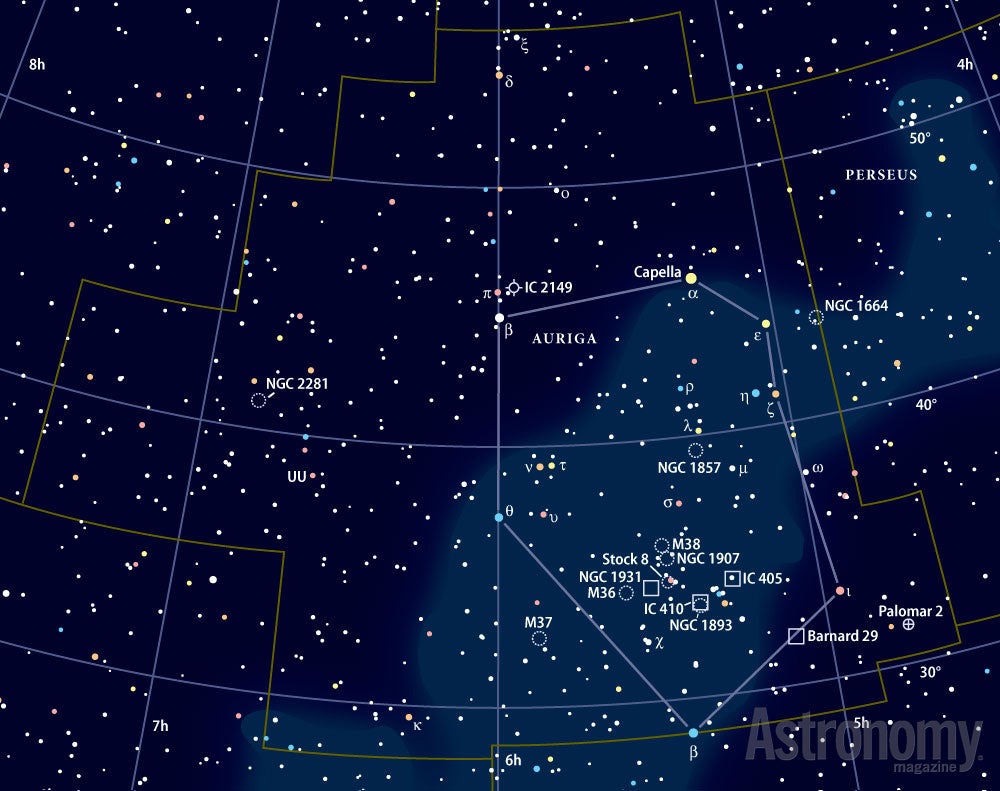Targets for January 15–22, 2015
Small telescope: Beta (β) Monocerotis
Small telescope: Open cluster NGC 2281
Large telescope: The Horsehead Nebula (Barnard 33)
This week’s first target is the triple star Beta (β) Monocerotis. It lies in the southwestern part of the faint constellation Monoceros the Unicorn, less than 4° from that star group’s border with Orion.
Beta Monocerotis is a star you won’t tire of observing or showing to friends. It’s a close triple star whose magnitudes are 4.7, 5.2, and 6.1.
Astronomers refer to them as the A, B, and C components, respectively. The separation between A and B is 7″; between B and C it’s 3″; and 10″ lie between A and C.
You’ll have no problem splitting any of these combinations through a 4-inch telescope at a magnification of 100x. All three stars appear white.
A nice northern star group
This week’s second object is open cluster NGC 2281 in Auriga. You’ll find this object 0.8° south-southwest of magnitude 5.0 Psi7 (ψ7) Aurigae.
NGC 2281 shines at magnitude 5.4, so from a dark observing site many observers can spot it without optical aid. One thing that helps its naked-eye visibility is that the cluster lies outside the band of the Milky Way that stretches through most of Auriga.
Another factor that will help you spot NGC 2281 is its size. With a diameter of 14′, it covers 20 percent of the area of the Full Moon.
Through a 4-inch scope at a magnification of 100x, you’ll spot two dozen stars in NGC 2281. Four stars forming a parallelogram sit at the cluster’s center. They range in magnitude from 8.8 to 10.1. Step up and view through a 12-inch scope, and you’ll count more than 50 member stars.
Get on the horse and ride
This week’s large-telescope target is the famous Horsehead Nebula in Orion the Hunter.
Because it occupies the 33rd slot on American astronomer Edward Emerson Barnard’s famous list of dark nebulae, astronomers also refer to it as Barnard 33, or simply B33.
You’ll find the Horsehead Nebula 0.5° south of magnitude 1.7 Alnitak (Zeta [ζ] Orionis).
In a previous podcast, I talked about the Flame Nebula (NGC 2024). If you can see that object easily, then try for the wonder many observers consider the ultimate challenge object — the Horsehead Nebula. This dark protrusion sits in front of emission nebula IC 434, which glows more faintly than the Flame Nebula.
Once you think you’ve located the Horsehead, look 15′ to its northeast for NGC 2023, a 10′-wide dot of bright nebulosity. And before you try to observe any of these objects, be sure to move brilliant Alnitak out of your eyepiece’s field of view.
Although some observers have viewed the Horsehead Nebula through telescopes as small as 5 inches in aperture, a 12-inch or larger scope definitely will bring out the horsehead shape. Remember that it’s bigger than you might think. B33 measures 6′ by 4′. A standard nebula or deep-sky filter will help, but to make this wonder really pop, use a Hydrogen-beta filter.
Expand your observing at Astronomy.com
StarDome
Check out Astronomy.com’s interactive StarDome to see an accurate map of your sky. This tool will help you locate this week’s targets.
The Sky this Week
Get a daily digest of celestial events coming soon to a sky near you.
Observing Talk
After you listen to the podcast and try to find the objects, be sure to share your observing experience with us by leaving a comment at the blog or in the Reader Forums.











